Subscribe now to get notified about IU Jharkhand journal updates!
An Empirical Study Of The Critical Influencing Factors Decisive For The Intention To Purchase Online
Abstract :
The world has been transformed by mobile phones. With the introduction of the internet - enabled mobile phones, the globe has become a little village where individuals have access to everything they need. People in India have been shopping online since beginning of aughts. Since then, momentum has been rapidly increasing. A number of articles on the subject of internet shopping have been published. The goal of this study was to learn about the inhabitants of Palamu district and their online buying habits. A questionnaire was administered to internet users of Palamu district on the premise of convenience, using a sample size of 500 and a statistical formula. Data being analysed using 384 acceptable questionnaires.Age, marital status, and family size were found to have no bearing on the decision to shop online. Gender, income, education, and occupation all have an impact on whether or not people shop online. Young men are better at using the internet than women. The majority of respondents first learned about online shopping websites from television, next from friends, and finally from newspapers. Some of them learned about it from coworkers, family members, relatives, and magazines. Males have been purchasing online for more than three years, while females have only been shopping for a year. Garments, mobile phones, tickets, and books were purchased in that order by females.Males prioritized buying mobile phones, tickets, consumer electronics, shoes, and books, with a few exceptions for computer and hardware components, video games, software, and leather goods,. The majority of individuals prefer to pay with cash on delivery option, followed by debit and credit cards. People shop online because it saves time, provides cheaper products, allows them to shop at their leisure and convenience, allows them to compare different products and prices, and boosts their product knowledge and information. Furthermore, no significant relationship was found between age, gender, income, and shopping duration and overall satisfaction with online shopping.
Keywords :
Internet users, Online shopping, Online shopping behaviour, Palamu.Introduction
Introduction
In India, e-commerce has changed the way people do business. From US$ 46.2 billion in 2020, the Indian E-commerce sector is predicted to expand to US$ 188 billion by 2025. It is estimated to reaching US$ 350 billion by 2030. The Indian e-commerce sector is expected to grow by 21.5 percent to US$ 74.8 billion in 2022.By 2024, India's e-commerce business is predicted to be worth US$ 111 billion and US$ 200 billion by 2026. A surge in internet and smartphone usage has fueled most of the industry's expansion. Because of the 'Digital India' campaign, the number of internet connections expanded dramatically to 830 million in 2021. Urban regions accounted for 55% of all internet connections with total wireless connectivity of 97%.
Digital India, Make in India, Innovation Fund, Start-up India, and the Skill India are some of the initiatives announced by the Indian government. The timely and successful execution of such schemes will almost certainly aid the country's E-commerce growth. The Government has taken significant measures to boost E-commerce in India. The Government e-Marketplace (GeM) platform had served 9.04 million orders totaling Rs. 193,265 crore (US$ 25.65 billion) to 58,058 customers from 3.79 million registered traders, businesses and service providers as of February 15, 2022.
Some recent developments in e-commerce sector in India:
In 2021, India's ecommerce industry received US$ 15 billion in PE/VC funding, up 5.4 times from the previous year. This is the greatest investment value ever obtained by any Indian industry.Amazon India introduced the One District One Product (ODOP) market on its portal in February 2022 to help MSMEs.Flipkart established the "sell back programme" in February 2022 to enable smartphone trading.Walmart invites Indian merchants to join its US marketplace in January 2022, with the goal of exporting $10 billion from India annually by 2027.Flipkart announced an expansion of its grocery services in January 2022, with plans to serve 1,800 Indian cities.
Literature Review
Online shopping behaviour describes a situation in which a person purchases products and services via the internet since it is required while shopping online. According to the literature, e-commerce growth and internet popularity enhanced online retail transactions (Zhang, Zheng & Wang 2020). Online shopping behaviour describes a situation in which a person purchases products and services via the internet since it is required while shopping online. According to the literature, e-commerce growth and internet popularity enhanced online retail transactions (Zhang, Zheng & Wang 2020).
Furthermore, in today's competitive market, businesses must employ new techniques to attract and keep clients (Aref&Okasha 2019). When compared to traditional shopping, online shopping has various advantages. For example, online shopping might provide a larger product selection and more personalised content thing, and spend less time looking for it (Levy & Weitz 2016). Online purchasing has become the norm. It is the most important region in the marketing world (Aref&Okasha 2019).
(Bhatti Rehman Kamal Akram, 2019) objectified in their study to look athow financial risk, product risk, privacy risk, and convenience risk influence online purchasing behaviour, using trust as a moderator. Data was collected for this purpose from students enrolled in HEC-accredited universities in Punjab, Pakistan. For this study, 500 questionnaires were employed. The partial least square equation modelling technique was used to conduct the analysis. The results show that online shopping behaviour is significantly reduced by financial risk, product risk and privacy risk. Online, trust significantly improves purchasing habits The relationship between (product risk, privacy risk, and convenience risk) and online trust is moderated by trust.This is an important study to look into the moderating influence of trust between people and their purchasing habits. According to this study, TPB and SET Theory plays an important role to enhance the moderating role of trust that reduce financial risk, product risk, privacy risk, convenience risk, and online buying behaviour.
Hairong Li, Cheng Kuo, and Maratha G. Rusell (1999) published a model of consumer online buying behaviour, which looked at the impact of shopping orientations on how customers use the Internet as a buying venue, as well as the role of channel knowledge and perceived channel utility. Consumer online buying behaviour is influenced by demographics, channel knowledge, perceived channel utility, and shopping orientations, according to the research. Education, convenience orientation, experience orientation, channel knowledge, perceived distribution utility, and perceived accessibility are all strong indicators of Internet users' online buying status.Shefali Kumar (2000) looked at the effects of demographic and personal factors on behavioural intentions. According to the findings, attitude, subjective norm, behavioural controls' perceptions, and prior purchases are all important determinants of behavioural intention. Subjective norm, hours spent online, money spent online, and prior transactions distinguish respondents with high and low behavioural intentions. Specialty Products had the highest behavioural intention of shopping online, followed by Personal, Information-Intensive, and Household Products.TimoKoivumäki (2001)conducted an experiment in a computer-mediated shopping environment to study the relationship between shopping experience and customer purchasing behaviour. People who made purchases in a Web-based grocery store utilised one of two interface designs: conceptual maps or a traditional list-type display. The study's findings revealed that interface design has no direct impact on the purchases made by respondents. The relationship between shopping experiences (consumer pleasure), the shopping process's conclusion, and the total monetary amount spent. Consumer satisfaction suggests that customer satisfaction determines recurrent purchases. These findings have significant ramifications for online retailers and storefront designers.Huizingh and Hoekstra (2003)investigated e-shopping and looked at a number of elements that influence why buyers return to a business or website. The study discovered that spending more time online by consumers improves the likelihood of them returning to a website or becoming customers by purchasing a product. As a result, building a website in such a way that customers are engaged and satisfied enhances the possibility of repeat business.With 346 undergraduate students as a sample, Melinda L. Korzaan and Paige S. Rutner (2003) conducted an online survey with a structured questionnaire utilising the Likert Scale to predict individuals' intentions to engage in online purchase transactions. The degree to which one views the Web as important, as well as one's sense of fun, were found to be significant predictors of one's attitude toward making Web purchases and sense of perceived Web proficiency. Consumer sentiments and purchase intents were found to be proximal antecedents of an individual's perceived skill at Web navigation.Ann Schlosser (2005)investigated how people use the content of consumer product reviews to make inferences and, as a result, the degree to which they are influenced by the review while purchasing online. The study found some evidence that message content, in addition to specific information about the source's credentials, can influence source impressions. Others have found that the persuasiveness of two-sided messaging is affected by whether the positive and negative traits are negatively associated (price and quality, or taste and calories) or uncorrelated (price and calories).
Changchit, ChuleepornDouthit, Shawn J, Hoffmeyer,Benjamin (2005) With the aims of identifying the variables considered as significant to online shoppers when making the decision to visit a website, to purchase from a website, to purchase more goods, to purchase at a higher price, and to provide feedback to a website, with 98 internet users selected on a convenience basis from the United States of America; discovered that the top reasons for consumers to return to a website, make a purchase, purchase more items, and be prepared to provide feedback are: Free Shipping, The most compelling reason to shop online is to save money. The most popular responses were free shipping, tax savings, and discounts.The facility to view product photographs and a simple return policy are less crucial than the financial difficulties. However, the findings revealed that when faced with other more essential satisfiers like saving money, the need to physically engage with things may be reduced to the point where it is no longer necessary.Gurvinder S Shergill and Zhaobin Chen (2005) with the goal of determining what variables online purchasers consider while shopping online and what various buyers' impressions of different websites are. New Zealand internet users selected on the basis of convenience filled 102 valid surveys via mall intercept survey. The study's findings, based on seventeen variables, classified buyers into four categories: trial, occasional, frequent, and regular online buyers, and revealed that website design, website reliability/fulfillment, website customer service, and website security/privacy are the four most important factors that influence consumer perceptions of online shopping. Darshan Parikh (2006)The success of internet auctioneers like e-bay, and Bazee, among others, has proved that the online medium is a viable conduit for both traditional and innovative business exchanges between retailers and customers, according to a study on "profiling internet shoppers." Other variables, such as the steady increase in internet users and broadband subscribers, as well as the quick speed of technological advancements and inventions, point to growing consumer acceptance of the digital media.
SendyFarag (2006) To evaluate the individual and residential characteristics of e-shoppers, researchers chose four towns (Utrecht, Nieuwegein, Culemborg, and Lopik) based on their varying levels of urbanisation and store availability. A total of 826 Internet users were chosen at random from 8,000 households. People who spend very little time on buying activities already buy online, according to a comparison of individual and residential features of e-shoppers with those of people with extended shopping durations. Women in the suburbs and less urbanised areas spend the least amount of time shopping and are the most likely to shop online. Under the condition that technological feasibility and costs are not additional barriers to use, time-pressed households are more likely to shop online.The findings revealed that e-shopping could be task-oriented (a time-saving method) for some persons and leisure-oriented for others. Because of their speedier Internet connections, city dwellers purchase online more frequently than suburban dwellers.
Virdi, Puri, Modi, Sehgal (2007) Their research indicated that online surfers' demography has a substantial impact on their buying behaviour, and security concerns about credit card fraud makes them wary of shopping online. The study also found that respondents' buying power differed greatly between the cities questioned, and it is suggested that the website be made more appealing, comprehensive, and support a certificate of authenticity in order to produce better responses to online shopping.
Palamu District
11.65 percent of the Palamu population as of the census taken in 2011 resides in the district's urban areas. There are a total of 226,003 people living in urban areas, with 118,751 males and 107,252 females. According to data from the 2011 census, the sex ratio in Palamu district's urban area is 903. The sex ratio of children in Palamu district was 916 in the 2011 census. There were 31,390 children ages 0 to 6 living in the urban area, with males making up 16,382 and females making up 15,008. The number of children in Palamu district is 13.80 percent of the total urban population. According to the 2011 census, the average literacy rate in Palamu district is 80.54 percent, with males and females having literacy rates of 87.07 and 73.30 percent, respectively. In fact, 156,749 people, including 89,137 males and 67,612 females, are literate in the urban area.
According to the census that was taken in 2011, rural villages make up 88.35 percent of the population in Palamu districts. There are 1,713,866 people living in rural areas in the Palamu district, with 887,551 males and 826,315 females. The sex ratio in Palamu district's rural areas is 931 females for every 1000 males. If data on the child sex ratio in Palamu district are taken into account, the ratio is 948 girls to 1000 boys. In rural areas, there are 298,338 children between the ages of 0 and 6 living there, with 145,177 males and 153,161 females. 17.26 percent of Palamu district's rural population is made up of children. According to 2011 census data, the literacy rate in Palamu district's rural areas is 61.31 percent. Literacy rates by gender were 49.22% and 72.52 percent, respectively. There was a total of 867,814 people who were literate, with 532,569 males and 335,245 females.
ResearchMethodology
ResearchObjectives
People have started buying online for a variety of reasons, including time restrictions. As a result of the digitalization effects, everyone from Tom Dickens to Harry Potter has begun to utilize the internet. Businesses have begun to hunt for new markets as a result of an oversupply of goods and services as well as ageing industries. This study will be beneficial to online marketers. The primary purpose of this study was to learn more about internet shopping habits of the residents of Palamu. The other sub-objectives were as follows:
- To learn what things people buy on the internet.
- To figure out how often they buy.
- To determine the customer's preferred payment method.
- To determine the level of technology's usability
- To find out the satisfaction level of online shoppers.
A descriptive study was conducted with 451 structured questionnaires distributed to internet users of Palamudistrictin Jharkhand state, to analyze their online shopping purchase intention and behaviour. Out of that 384 online shopper responses could be used.
ScopeofStudy,Sampling DecisionsandDataCollection
ThescopeofstudywasthePalamu district in the state of Jharkhand.500 internet users wereselected as a sample for data collection on the basis of simple random sampling technique sothat the statistics need to be reliable and represent the population parameters as close aspossible within a narrow margin of error.In order to determine the sample size at 95%confidence level, assigning equal chance to all internet users as being online shoppers and nonshoppers,with 5%margin of error,thesample sizen was computedas under:
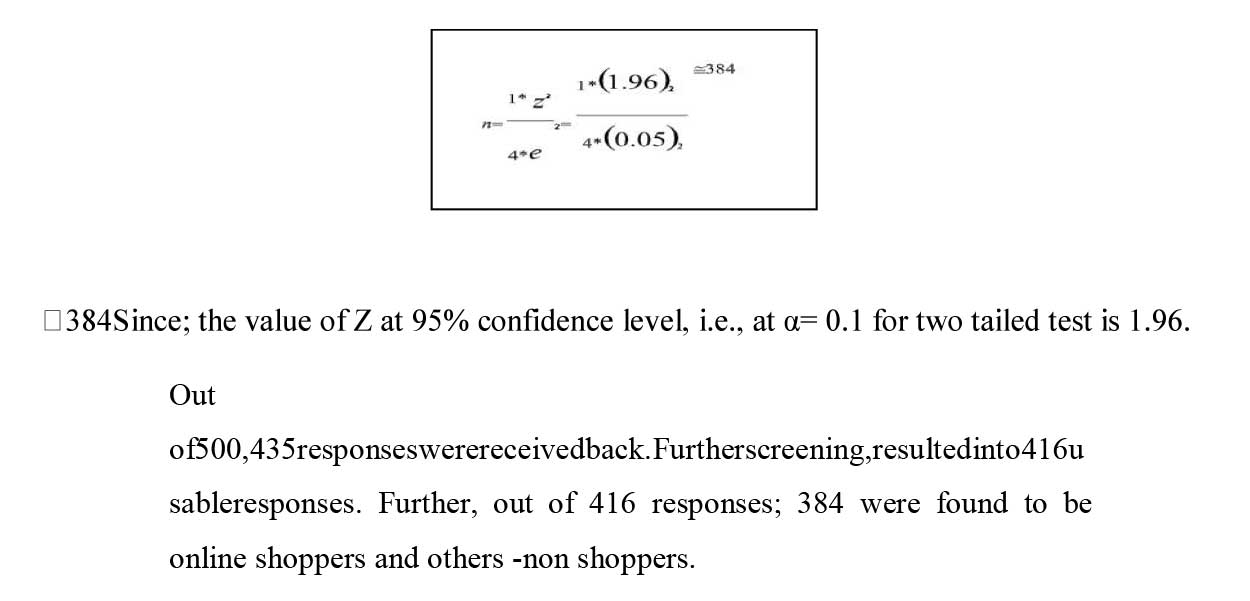
QuestionnaireDesign
The questionnaire was designed based on a thorough review of the extensive literature. Somequestions were based on the questions used in previous research andused in their originalform while others were modified slightly to address the specific nature of this study.Finally,some of the questions were developed solely for this survey to address important concepts notpreviouslyaddressed byprevious studies.
StatisticalTools
Thefilledquestionnairesasreceived;werescrutinizedindetailandcodingsystemwasestablished for all the questions to quantify the qualitative aspects.After processing, theinformation was entered in to a master table, from which various tables were incorporated inthestudyas per therequirement, forfurtherstatistical analysis.
To meet the objectives,simple techniques like frequency counts and percentages were usedfor data analysis to bring the meaningful results. Descriptive and Inferential Measures wereused. To evaluate the online shopping behaviour of the selected respondents a Chi squarestatisticstest was conducted.
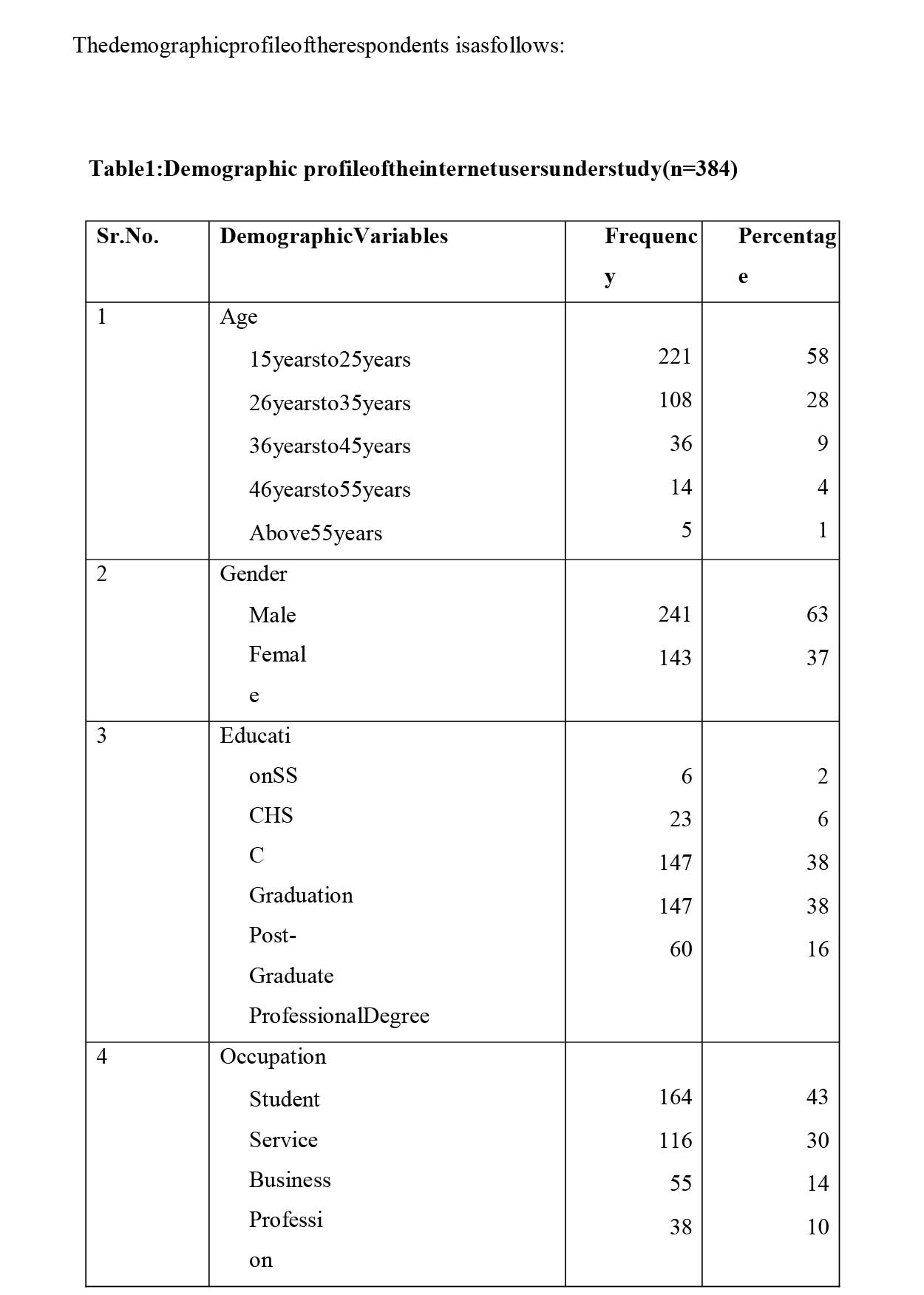
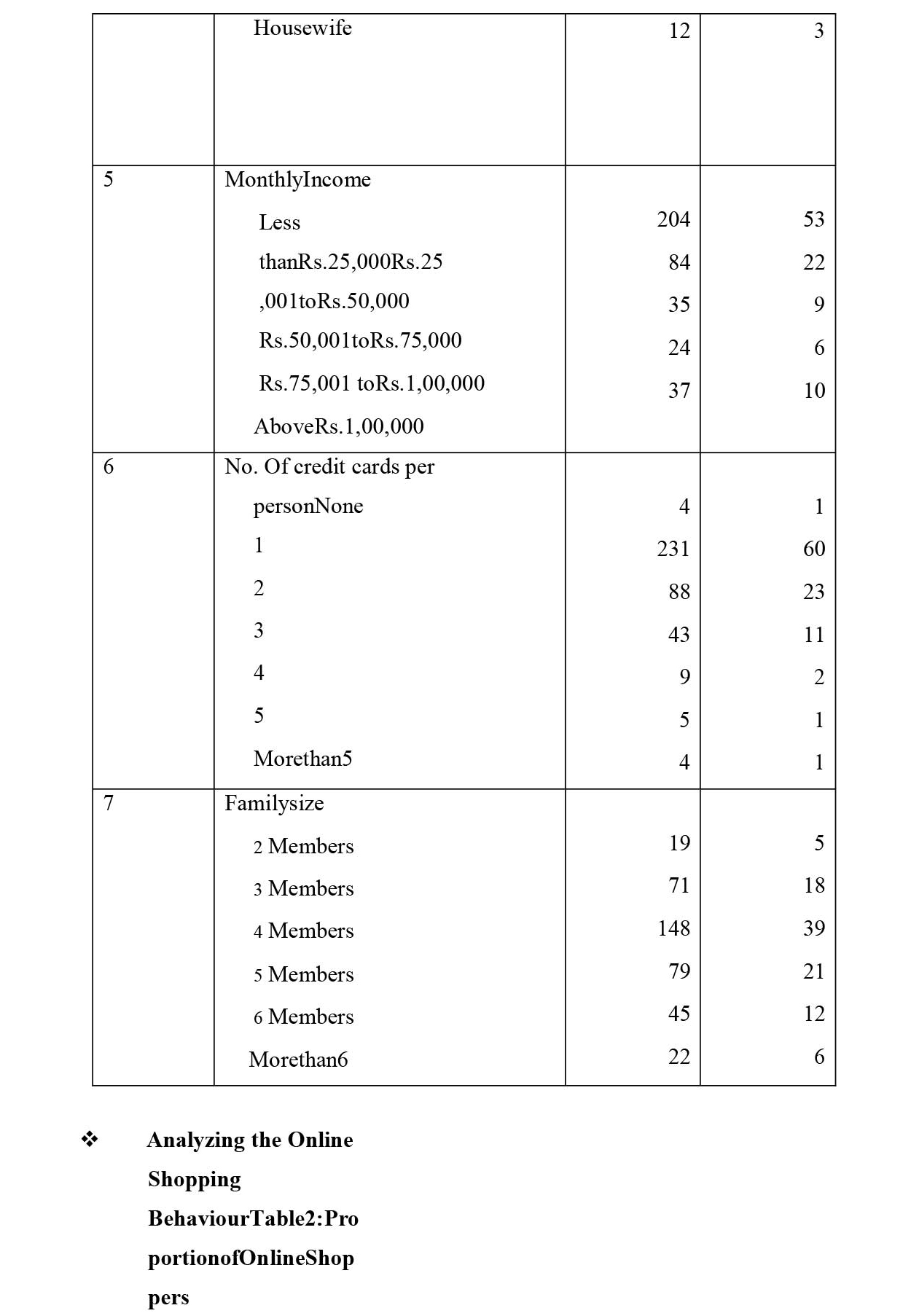

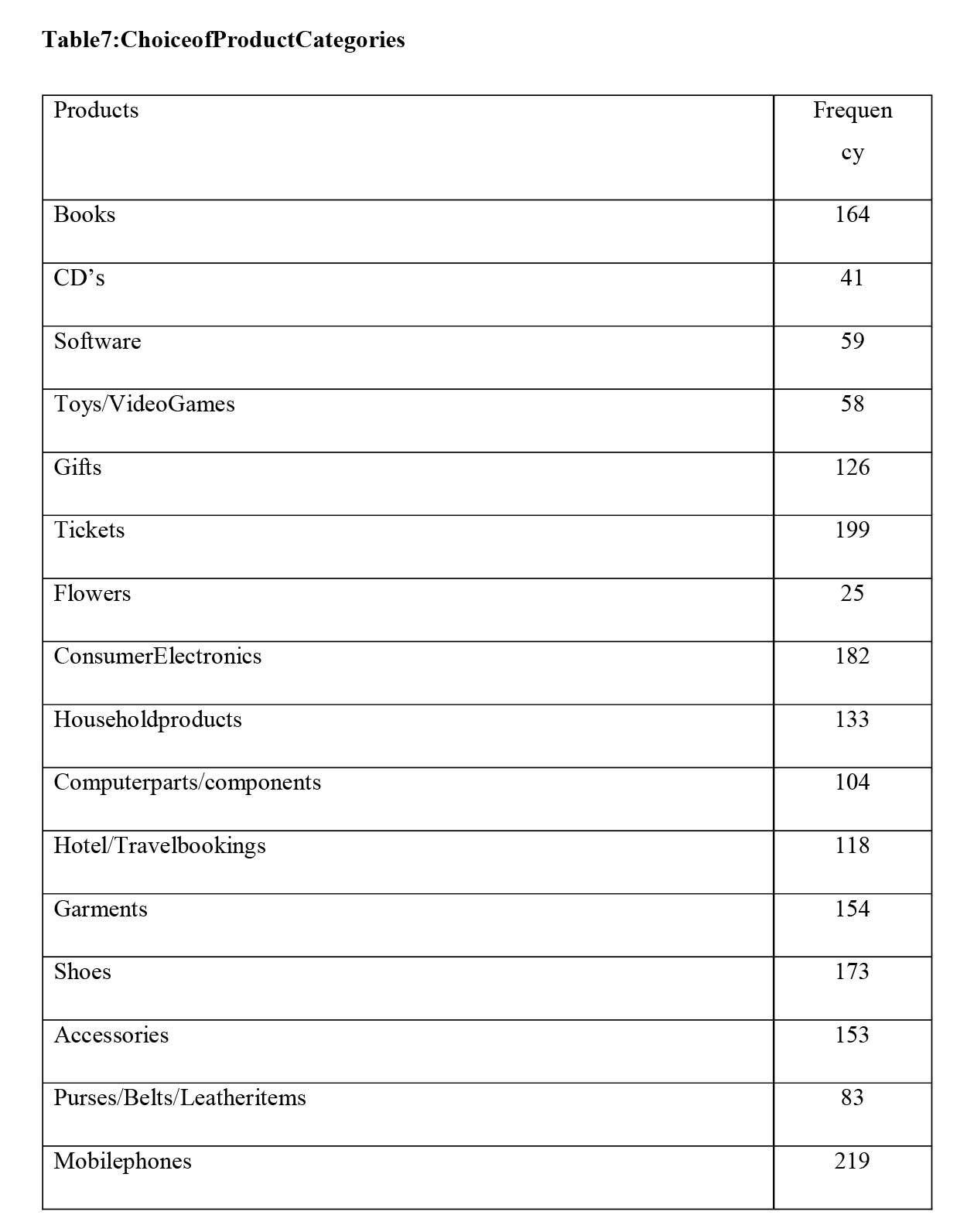
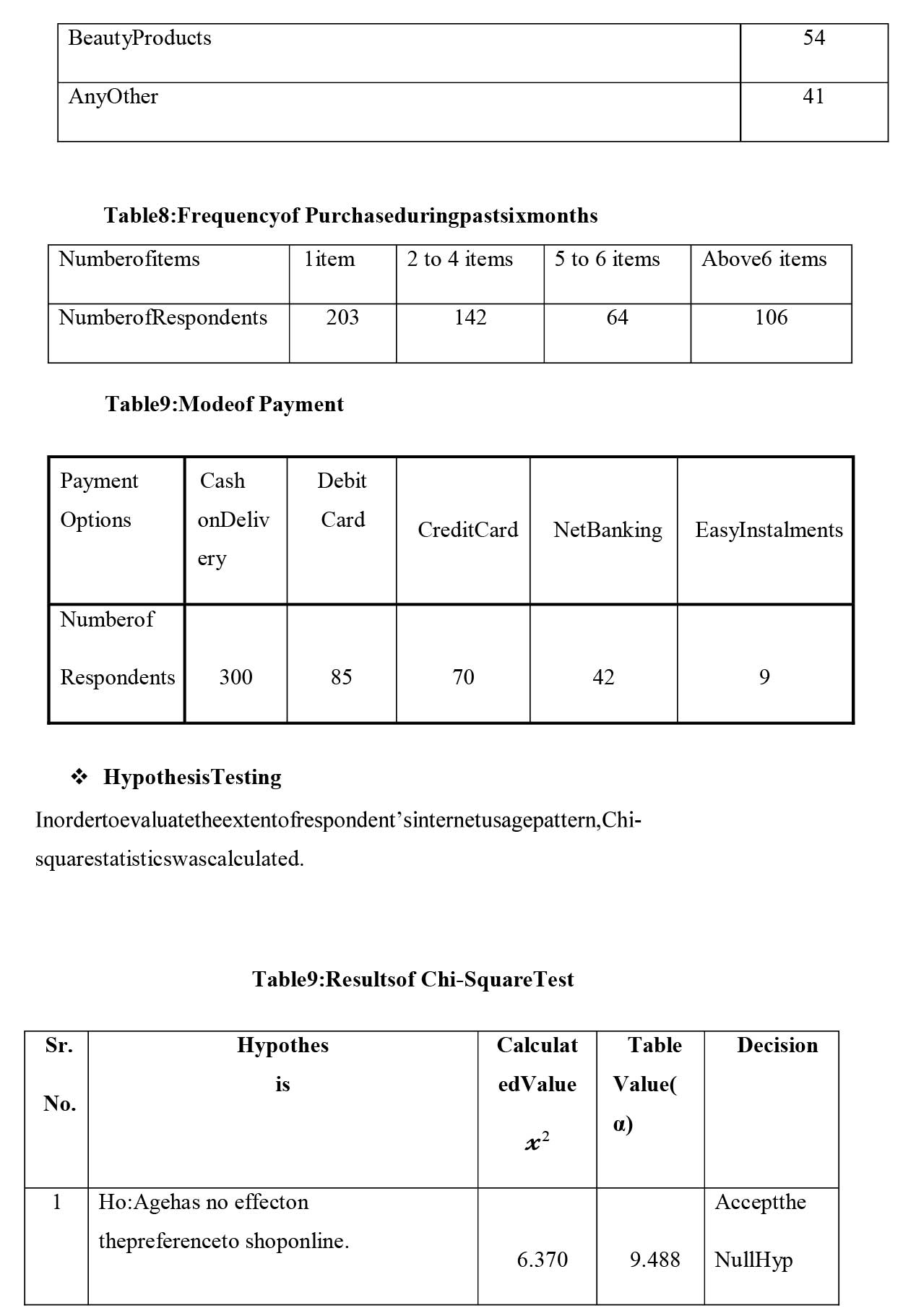
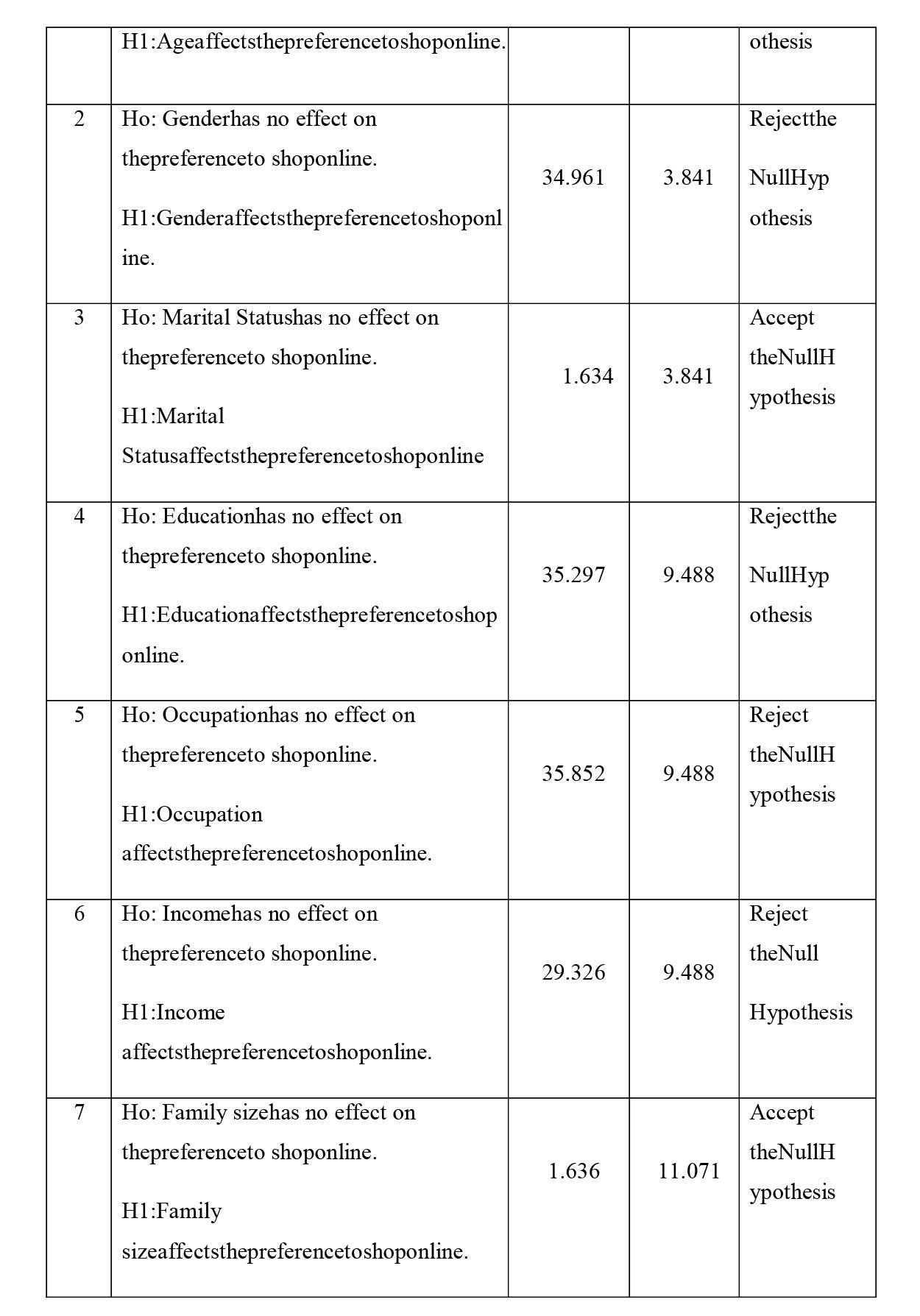
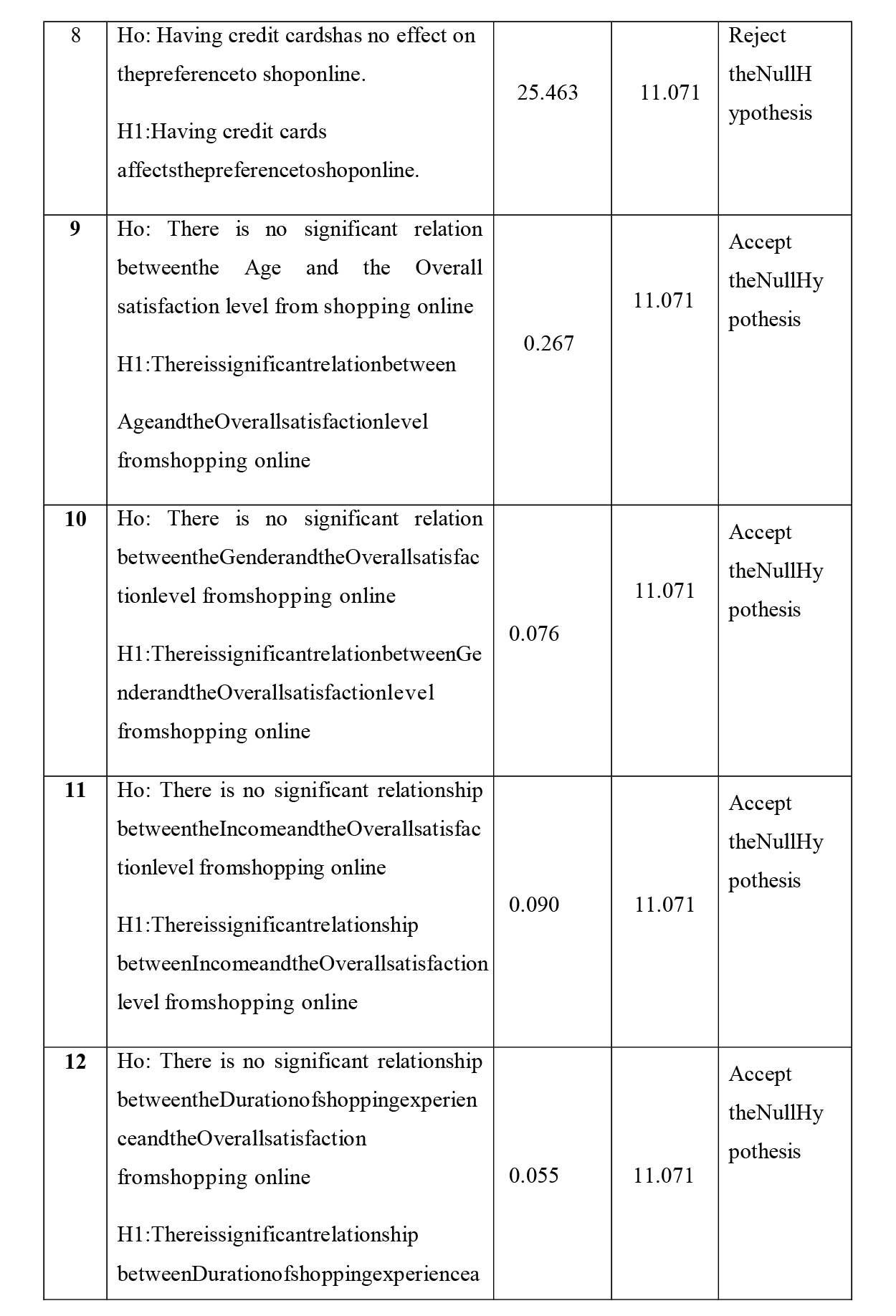

MajorFindings of theStudy
- Age, marital status, and family size have no effect on preference to shop online.
- Gender, income, education, and occupation all impact the preference of customers to shop online.
- The majority of internet users are between the ages of 15 and 35, with UG degrees or above.
- Male internet users account for 57%, while female internet users account for 43%.
- Men are better at using the internet than women.
- It was found that the majority of respondents learned about online shopping websites from television (238), friends (234), and newspapers, in that order. Some of them learned about it from co-workers, family members, relatives, and magazines.
- Half of the 384 respondents have been buying online for one (95) or two years (97), while the other half has been doing so for more than three years.
- Males have already been shopping online for more than three years, while ladies have only been shopping online for two years.
- The majority of respondents (219) have purchased mobile phones, tickets (199), books, electronic products, shoes, garments, accessories, household products, gifts, hotel and travel reservations, computer and hardware components, leather items, software, video games, and other items from online websites.
- Females purchased clothing, mobile phones, tickets, and books in that order. In order of preference, men bought mobile phones, tickets, consumer electronics, shoes, and books.
- During the previous six months, 203 respondents purchased only one thing from a website, while 142 purchased two to four items.
- The majority of respondents (300 out of 384) prefer to pay by cash on delivery, followed by debit and credit card.
- The majority of respondents say that they buy online because it saves time, offers things at lower prices, allows them to purchase at their leisure and convenience, allows them to compare different products and prices, and boosts their product knowledge and information.
- The majority of respondents (except who are working) use the internet for entertainment, social media and chatting. The respondents aged 15 to 25 use the internet for news, shopping, games, and entertainment as well.
- There is no substantial relationship between age, gender, income, or shopping duration and overall satisfaction with online shopping.
ManagerialImplications
The report is beneficial to online product marketers. They are able to comprehend online customers' behaviour, purchase decisions, purchase behaviour, and motivations for shopping online. Companies can then adjust their methods to fit their offerings to the tastes, requirements, and desires of their clients, attracting more and more customers online.
FurtherResearch
In the future, the study might be reproduced with a larger sample size, and a cross study could be conducted to better understand online consumer behaviour, which would be beneficial to marketers, like, how to increase an online user's perceived value and trust. If a poll is expanded to various geographic locations of India, the likelihood of online buying behaviour and the profile of consumers may differ. Future researchers could do a comparison study of consumers from other locations, states, or countries.
Conclusion
Online purchasing has reached new heights. People have realized the value of internet shopping due to a lack of time and the complications of life. The government has also taken significant steps to restore public confidence. Customers' concerns have also been taken seriously by e-commerce businesses. According to the findings, age, marital status, and family size have no impact on the option of shopping online. Gender, income, education, and occupation all have an impact on whether or not people shop online. Online is more appealing to the younger generation. Males are more skilled and have been shopping for clothes, phones, electronic devices, and tickets for the past four years, in addition to reading news and communicating with friends on the internet.Women were late adopters, buying for clothes, phones, and books on the internet. The conclusions of the study may assist internet businesses in framing their strategies in the light of the findings.
REFERENCES:
- Aref, M. M., &Okasha, A. E. 2019. Evaluating the online shopping behavior among Egyptian college-educated community. Review of Economics and Political Science, 5(1), 21-37.
- Bhatti, A., & Rehman, S. U. 2019a. Perceived benefits and perceived risks effect on online shopping behavior with the mediating role of consumer purchase intention in Pakistan. International Journal of Management Studies, 26(1), 33-54.
- Changchit,C.,Douthit,S.J.,&Hoffmeyer,B.(2005).Onlineshopping;Companybusinessmanagement.JournalofAcademyof BusinessandEconomics,5(3).
- Choudrie, Jyoti&Dwivedi, Yogesh Kumar (2005). Investigating the research approaches for examining technologyadoption issues.Journal of Research Practice1(1): Article - D1.
- Farag,S.(2006). E-shoppinganditsinteractionswithin-storeshopping.UtrechtUniversity.
- http://www.iamai.in/
- https://www.census2011.co.in/
- Huizingh,E.K.,&Hoekstra,J.C.(2003).Whydoconsumerslikewebsites?JournalofTargeting,MeasurementandAnalysis forMarketing,11(4), 350-361.
- Huizingh, E. K., & Hoekstra, J. C. (2003). Why do consumers like websites? Journal of Targeting, Measurement and Analysis for Marketing, 11(4), 350-361.
- Koivumäki,T.(2001).Customersatisfactionandpurchasingbehaviourinaweb-basedshoppingenvironment. ElectronicMarkets,11(3),186-192.
- Korzaan, M., &Rutner, P. (2003). Intentions to purchase and the online experience. AMCIS 2003 Proceedings, 41.
- Kumar,S.(2000).Consumers'behavioralintentionsregardingonlineshopping.
- Kumar, Shefali. Consumers' Behavioral Intentions Regarding Online Shopping, thesis, August 2000; Denton, Texas. (https://digital.library.unt.edu/ark:/67531/metadc2634/: accessed May 28, 2022), University of North Texas Libraries, UNT Digital Library, https://digital.library.unt.edu.
- Levy, M., & Weitz, B. A. 2016. Retailing Management. McGraw-Hill, Irwin, CA.
- Li, H., Kuo, C., &Rusell, M. G. (1999). The impact of perceived channel utilities, shopping orientations, anddemographics on the consumer's online buying behavior. Journal of Computer-Mediated Communication, 5(2),JCMC521.
- Parikh,D.(2006).Profilinginternetshoppers:AstudyofexpectedadoptionofonlineshoppinginIndia.IIMBManagementReview,18(3),221-231.
- Schlosser,A.E.(2005).Sourceperceptionsandthepersuasivenessofinternetword-of-mouthcommunication.ACRNorthAmericanAdvances.
- Shergill,G.S.,&Chen,Z.(2005).Web-BasedShopping:Consumers'attitudestowardsonlineshoppinginNewZealand. Journal of electronic commerceresearch,6(2),78.
- Verhagen,T.,&VanDolen,W.(2011).Theinfluenceofonlinestorebeliefson consumeronlineimpulsebuying:Amodelandempiricalapplication.Information&Management, 48(8), 320-327.
- VirdiS,Puri,ModiandSehgal(2007).PragmaticBuyersorBrowsers?Astudyofonlinebuyingbehaviour. JournalofIndianManagementStudies,2,141-166.
- Zhang, J., Zheng, W., & Wang, S. 2020. The study of the effect of online review on purchase behavior. International Journal of Crowd Science, 4(1), 73-86.
